Home on the Thames
London's evolution is measured in centuries, not years. But when half of the city's new abodes go to foreign buyers—frequently as third or fourth homes—who's steering the design? Assessing Battersea's return from 30 years in the desert, just in time for a brand new American embassy.

London is forever changing, scrubbing itself down, scouring the land, digging deep beneath the thick clay soil, stamping in dozens and dozens of sturdy concrete piles, and then starting again with something new. It’s impossible to look at a brand new building and imagine it being destroyed, but that’s exactly what happens, every day, somewhere in the capital.
Few parts of London have been so comprehensively and frequently torn up as Nine Elms. East of Battersea, west of Vauxhall, Nine Elms borders the Thames directly opposite the genteel squares and stucco terraces of Pimlico on the north bank of the river. A low-lying district of industrial estates and warehouses, it is bookended by the abandoned brick hulk of Battersea Power Station to the east and the stacked tiers of apartments that make up St George Wharf at Vauxhall Cross to the west (this author’s personal bête noire of recent London architecture). The entire area—neighborhood is too cozy a term—is corralled by railways on raised viaducts and bisected by Nine Elms Lane, a four-lane highway.
And yet, if one drinks in the warm hyperbolic prose of the realtor, Nine Elms is a place on the up, home to London’s new “Embassy Quarter,” a vibrant, exciting neighborhood with a new, purpose-built American embassy at its center, a sound social and financial investment for the future, even though it will be many years before the first curtain is hung and the first chain café sets out its tables.
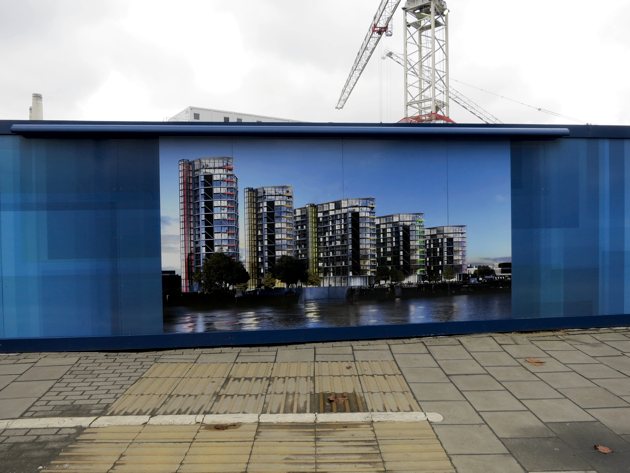
How does this dark art function—the ability to describe imaginary spaces for people who will, in all probability, never live in their apartments, let alone visit them—and how do cities reinvent themselves?
I have driven along Nine Elms Lane perhaps several hundred times over the last two decades. In the last 12 months, the previously unchanged façades, fences, and walls that lined this once featureless stretch of road have been replaced with hoardings and sales offices, festooned with promises of a brighter tomorrow and an enhanced lifestyle. The car is a deeply unsatisfying way of experiencing such urban upheaval, so I resolve to take a walk down Nine Elms Lane—my first foray on foot along this route—to see whether its past, present,and promised future can be reconciled.
First impressions are not favorable, not helped by the bitterly cold weather. This is about as “non-place” as Central London gets. As I leave Battersea Park station behind—a charming but faded Victorian terminus sandwiched between high-level rail lines—it soon becomes apparent that there is nothing for the pedestrian here. Nothing at all.
The car is a deeply unsatisfying way of experiencing such urban upheaval, so I resolve to take a walk down Nine Elms Lane to see whether its past, present,and promised future can be reconciled.
Battersea Dogs & Cats Home is the first waypoint, a well-loved London landmark that has been here since 1871 but also a rather dispiriting one, both in the banal architecture of its modern extension and the implications of the charity’s open door policy, which sees it taking in thousands of unwanted animals and euthanizing the ones that can’t be found a new home. Sometimes you can hear barking and yelping from the train on the platform above. Sometimes there’s nothing, the noises carried off by wind. Perhaps. I walk quickly past. On the other side of the broad road there are a stand of mediocre new flats. One day they’ll have a grandstand view of a decade’s worth of upheaval as Battersea Power Station finally becomes the capital’s biggest building site later this year.
Battersea Power Station is the most significant building on the lane and has been ever since construction began in 1929. It is massive, its scale exaggerated by the surrounding empty wasteland. Disused since 1983 and subject to plan after plan, scheme after scheme, the power station is finally to become the centerpiece of a big new development, its stark Deco-esque brickwork to be abutted by steep canyons of new apartments that will carpet the site.
London’s skyline is characterized by gaps and glimpses, alignments and strange conjunctions, as well as corridors of “protected views” that are supposed to remain forever unblemished. Construction on the power station is promised to start in the summer, so these views of the building marooned, roofless, and forlorn are to be savored, despite the cold. These are sights that will soon disappear forever.
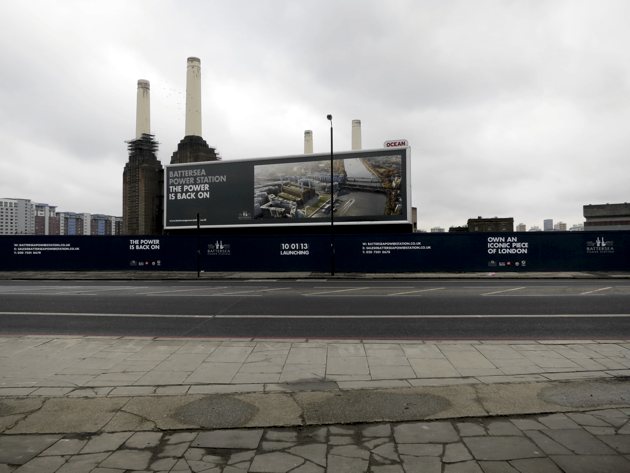
Beyond the power station and one is truly in no man’s land, a vast acreage of nothing in particular, barely a mile from some of the world’s most expensive residential real estate. There is no there, there, as Gertrude Stein once said disparagingly of Oakland. I pass a shiny black lake of new tarmac, on which sits even shinier new BMWs, destined to be distributed around the capital’s many car showrooms or shipped off to customers. The market building itself lies beyond the railway line, almost invisible to those who don’t know it, but acting as a huge physical buffer between Nine Elms and its neighbors. The 21st-century equivalent of barrow boys drive their white panels vans at speed down the ramp beneath the deep brick railway arches, screaming their horns in celebration.
The buildings beyond settle into ’70s-era commercial dross, including a large Post Office distribution center. Someone, somewhere has done the sums and decided it makes more sense to sort the mail elsewhere, for all of this is under sentence of imminent death, with master plans being drawn up for yet more apartments.
The first sign of new life is Riverlight, five stepped apartment buildings that fan out across a narrow strip of land once occupied by yet more warehouses. The site is heralded by an extravagant sales office, a blue panel clad iceberg dominated by a large LED screen, upon which glossy computer generated images are shown to passing traffic. Inside, it is decked out in typical show flat style, all contemporary furniture, scattered art monographs, abstract prints, rugs and cushions, and fresh vases of flowers. There is also a beautiful model of the whole district, with buildings rendered in softly opaque Perspex, lit glowingly from within. Everything is here, from the proposed blocks surrounding the power station to a glass cube that represents the forthcoming American embassy.
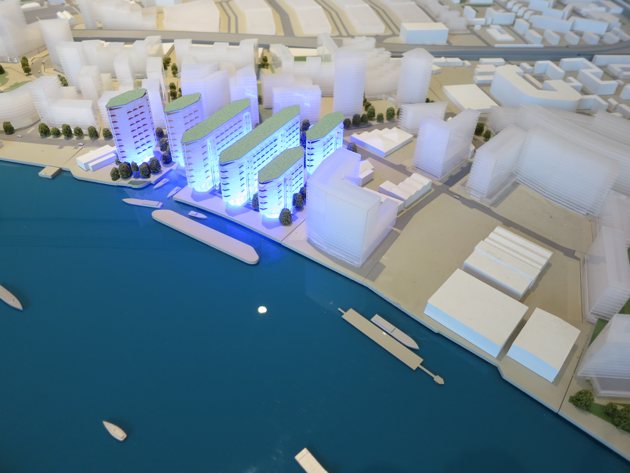
The Thames was once the economic generator for the whole city. So where is the river in all of this? Despite its proximity it is well hidden, as it has been for much of recent history. The Riverlight brochure shows the new blocks cantilevered out over a generous new riverside walk, with cascading water features, healthy young trees, and the scattered tables and chairs of inevitable café culture. Today, the wide sweep of Nine Elms Lane scrubs away topography—a tarmac veil drawn over what was once meadows, woodlands, creeks, and pastures, scattered first with farms and mills. The original copse of “nine elms” gave their name first to a tavern, then to the road itself. The river lured workshops and pottery works in the pre-industrial era, clustering along the river’s edge in a jumble of wharves and small works. But there’s precious little evidence of any history.
Battersea Power Station itself was built on the site of the Southwark and Vauxhall Water Works, a market garden and a network of wharves and creeks, including the Mill Pond, a tidal inlet with a couple of small islands, now remembered by Mill Pond Close. In Sherwood Ramsey’s 1913 history of Battersea, the nebulous, non-space character of this stretch of the city was already in evidence. Ramsey wrote that “in the early part of the nineteenth century ‘Go to Battersea’ was a by-word much used by Londoners who wished to show contempt for their fellows.”
For much of the 19th century it really can’t have been much fun, a place of industry and water works—including the site of a major cholera outbreak in the 1850s, traced back to the stagnant, sewage-ridden pools of the water works, who had taken it straight from the disease-ridden Thames before pumping it to their luckless subscribers. There’s still a pumping station here, more or less on the site of where the old Mill Pond joined the Thames, but its low-key and functional, with no sign of life or use.
The new developments all promise a similar thing—to open up this stretch of the Thames to the city, providing a new, broad path running along the river bank all the way from well before Battersea to Waterloo and beyond. The Thames’s choleric days are long behind it, as is its role as a giant conduit for the capital’s effluent. But it’s January, and the banks are cold and exposed, empty and windswept. Parts of the path have been there for decades, but are now tucked away down a narrow passage between high wooden temporary hoardings. It leads down to a motley flotilla of houseboats, their moorings hidden behind a building site, their hulls listing in the mudflats revealed by low tide.
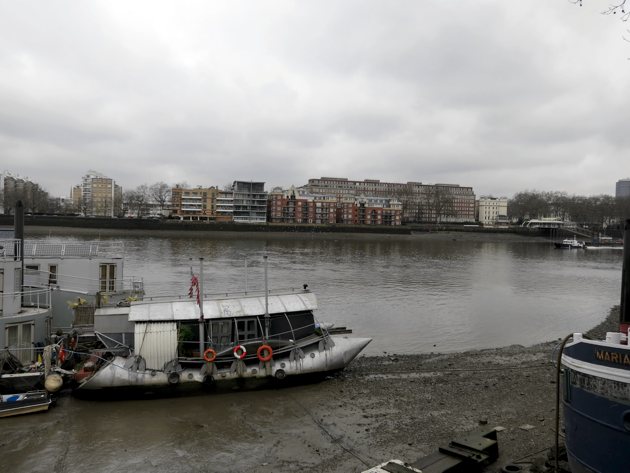
Walk to the east and the river becomes more accessible, thanks to the existence of two red-brick apartments buildings, one a post-modern castle and the other a brickish, more austere, late ’70s, early ’80s confection. They’re architecturally quirky by anyone’s standards, gaining a gawky respectability over the years as sleek modern successors rose up alongside them.
The only working wharves that remain are back to the east, and deal with fuel and waste, not products or manufacturing. Cringle Dock, a waste-processing site, gets the bulk of its materials by barge, brought down river. A few years ago you could drive up and offload unwanted household goods from the back of your car, 24 hours a day. Its close proximity to Chelsea meant a higher class of rubbish, evidenced by the stack of decent-looking furniture and barely out of warranty electronics that the site managers would surreptitiously fish from the skips and then gloat about to anyone that asked.
Back on the main road, all that’s visible behind the fences that shield “Embassy Gardens” is a mountain of topsoil. Ultimately, this scrubbed site will become Embassy Gardens—2,000 homes alongside shops and restaurants and a “linear park” running to the nearby power station, all overseen by Ballymore, an Irish developer. At the centre of the development will be the new American embassy, the glittering lure for almost everything that surrounds it. Without America, would this forgotten part of London have ever been able to pick itself up? The local borough, Wandsworth, evidently thought so, successfully luring the embassy to what must sure have been an unprepossessing and barren site. With an anchor tenant—in developer-speak—as prestigious as this, regeneration will surely follow.
The American move to Vauxhall is fundamentally prompted by economics. The current embassy is a diplomatic anomaly—the site it sits on is not owned by the United States, unlike the vast majority of overseas diplomatic posts. Located in Mayfair and designed by the Finnish-American architect Eero Saarinen, the current U.S. Chancery is in the heart of the Grosvenor Estate, a huge property portfolio owned by the Duke of Westminster, the UK’s wealthiest landowner. The Grosvenor Group’s $11 billion holdings date back to the 17th century, when 500 acres of what is now Mayfair, Belgravia, and Pimlico were inherited by Mary Davies, who subsequently married Sir Thomas Grosvenor. The Group declined to grant a freehold to the American embassy, and the building itself, a concrete box of refined detail and proportions, began to assume an increasingly white elephant-like status as the years marched on.
Just as the architecture itself swung back into fashion—it is Saarinen’s only British work and has many admirers, this writer included—security concerns transformed the west end of Grosvenor Square into a ugly obstacle course of concrete barriers and obstacles. Recent work has consolidated the massive security requirements into two new pavilions, high fences, and a strict queuing system, but it’s a band-aid solution that’s lamented by local residents, the local council, and, presumably, the U.S. Chancery itself, trapped in a concrete barred box of its own making, prevented from making large-scale alterations by rigorous building codes and increasingly inconvenienced neighbors.
The wide sweep of Nine Elms Lane scrubs away topography—a tarmac veil drawn over what was once meadows, woodlands, creeks, and pastures, scattered first with farms and mills.
The embassy will go, as will the barriers. The building will stay, in some form or another, perhaps as a sleek modern hotel designed to capitalise on the period detailing. Its new owners are Qatari Diar, the property arm of Qatar’s sovereign wealth fund that already has large chunks of London in its portfolio, including the billion dollar Chelsea Barracks site a few miles away.
A few weeks earlier I visited the embassy in a spectacularly unsuccessful fashion, mistiming a visa application and riling everyone in the process. I had come unprepared for the arduous security procedures. Twice I had to leave the snaking queue to get inside the embassy, first to backtrack and retrieve my “invitation to interview” from a small photography studio on Oxford Street that seemed to serve as an unofficial gatekeeper for the embassy. I rejoined the queue and got to the front, then realized that my mp3 player was strictly forbidden. Back I went to Oxford Street and stowed it alongside my cellphone.
I finally rejoined the drizzle-streaked queue, at the back. I’d like to report things went well once inside Saarinen’s concrete façade, but the day was against me. After being ushered in, baggage checked and metal detected, I was given a ticket and a half-hour wait before having my documents scrutinized. Misunderstandings characterized the terse interview that followed. I wasn’t getting my visa today, or tomorrow, but the following week. A mild stand-off with the embassy official followed, during which my rhetorical but clearly unacceptable questions brought an angry accusation and a hard, defiant stare from behind the bulletproof screen. Perhaps she was having a bad day too. But then she didn’t have to cancel her business trip the following week, or make a groveling phone call to the people who’d paid for the flight. I slunk away, lost in angry thoughts of watch lists and burnt bridges.
The new embassy won’t just legitimize Nine Elms as a place to go, it will—in the words of a Ballymore sales lady—bring “excellent security” to what isn’t a terribly salubrious part of London. Given that Britain’s foreign intelligence service, MI6, has its HQ less than half a mile away in Vauxhall, expect this to be one of the most heavily surveyed part of the capital, a CCTV bonanza.
Security has driven the design of the new embassy. A north-facing glass cube, surrounded by a semi-circular pool and a sextet of square region-themed gardens (Mid-Atlantic, Canyonlands, Potomac, Pacific Forest, Midwest, and Gulf Coast), the embassy is being designed by KieranTimberlake, a Philadelphia-based firm of architects specializing in low-energy design. KT were a surprise winner in the invited commission, as it was widely expected that the job go to a grandee of U.S. modernism, like Richard Meier, Thom Mayne, or I.M. Pei, all of whom submitted convincing proposals. Perhaps the assessors considered the lesser-known firm would be more amenable to what will inevitably be a very fluid, complex, and long, drawn-out design process. Perhaps their environment credentials trumped big names.
I first became aware of their work via the Loblolly House, a delightful piece of pre-fabricated residential architecture designed for a waterside site in Chesapeake Bay; if the giant cube of Nine Elms can retain a small percentage of its tiny antecedent’s qualities, it will turn out well. But will it prove a noble successor for Saarinen? Hard to say. The original embassy building stood as both counterpoint and evolution of the graceful Georgian square, the very definition of “contextual modernism” for its supporters, the archetypal concrete carbuncle to its detractors. There’s no existing urban realm in Nine Elms. The apartment blocks that will rise alongside and eventually encircle the new embassy are competent, but undistinguished, rendered in the stock architectural language of vertical detailing, tall windows, brick walls and a galloping, slightly off-kilter rhythm to the façade. Set alongside, the KT cube, lit from within and given spatial separation by its security demands, has potential to stand out. But it will be on show, alone, without the crutch of context.
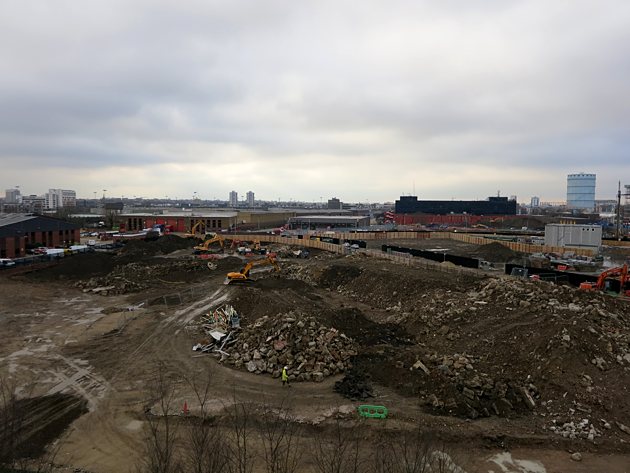
Next door to the embassy site is the sales office for Embassy Gardens, signposted by very contemporary, bold serif letters. It serves as an oasis from the building site outside; a warm, glossy marketing suite with hardwood floors, unused furniture, free coffee, and lovely, lovely models. I gaze adoringly at their fine features, glossy surfaces, and the bright lights that shine from deep within them. A skilled model maker can make any building look brilliant at 1:50 scale. It’s a slow day, and it is very cold, and I figure real estate sales people are taught not to discriminate against cheap shoes and tatty overcoats, so I feign interest in buying a flat.
It turns out there are just a handful left, but I get a rousing sales patter on these last few units, presumably the runts of the development. The lady from Ballymore dismisses her rivals at Riverlight for talking investment levels above all else, stressing that her company is about building communities, not assets. “It’s designed for living your own life, rather than buy to rent,” she says, a crucial distinction that’s meant to affect a veneer of authenticity on these mocked-up apartments. “It’ll have more soul and character than other developers,” she continues. The mocked-up flats are certainly appealing, generously sized for London, very highly specified with plenty of kitchen gadgets (“it’s an Irish company, so they had to have a minibar”) and interiors schemes seemingly clipped straight from a lifestyle magazine. Breakfast at Tiffany’s plays on the flatscreen (on every flatscreen, I soon discover).
The sales office has a roof terrace, from where I look across acres of emptiness that’ll soon be home to the heavily surveyed glass cube. Behind me is “The Tower” at St George Wharf, a thumpingly unsubtle residential column of glass that is nearing completion. The crane on its peak will be struck by a private helicopter the following morning; the pilot dies after the stricken craft plunges to the ground a few blocks away, also killing a man on the ground as he walked to work. One wonders if the eventual owner of the £50m triple-story penthouse will ever think of this clattering tragedy as he (or she) looks out over London, imagining their field of view suddenly taken up by a looming, twisting machine that rears out of the mist.
Despite Britain’s recession being slowly cranked over the drop of what is now being a called a “triple dip” recession—all the plunges without the roller-coaster thrills—developers aren’t having any trouble selling large swathes of these upscale apartments “off plan.” The day before I did this walk the headline in London’s Evening Standard read “Battersea bonanza as £600m flats go in 4 days.” Someone is buying into this. Three years before they’ll be able to move in—and this to a site with nearly three decades of false starts and abandoned plans—investors queued up to buy the bulk of 800 units released to the market. The key word is “investors.”
The more expensive the development, the more likely its apartments are to be second, third, or fourth homes, hermetically sealed and serviced pied-à-terres that make a better investment than bottomless hotel bills. One Hyde Park, widely feted as the world’s most expensive apartment building when it opened in 2010, was criticized when statistics showed that only three of the building’s 85 units were occupied full time, and the rest were largely owned by shell companies operating out of tax havens.
A city has to pay its way, as well as simply exist. Grain, grist, and patina are that most unknowable of commodities, their values impossible to determine in any market.
Smaller flats in less salubrious parts of London—such as Battersea—are still being pitched at the world’s diasporic community of HNWIs (high net worth individuals), people who buy flats to house university-age children or for holidaying relatives. Battersea Power Station’s developers “toured” the property like a rock band, taking a sales roadshow to Singapore, China, Malaysia, and Hong Kong in advance of releasing flats on the UK market. According to the Wall Street Journal, nearly half of all new London homes go to Asian buyers. At Embassy Gardens, studio apartments started at £420,000 (they’ve all gone).
The London of these new residents relies solely on big ticket regeneration as a means of evolving its history. Whereas the major changes wrought on cities throughout the last two hundred years of history have been the effects of technology—sanitation, the railway, the steam engine, the elevator, the motorcar—there’s nothing conspicuously innovative about the drive to replace light industry with lifestyle and leisure.
Even so, these developments are planned and executed with meticulous care, as much financial product as they are architecture. Subtle shifts in the market and dubious long projections can all conspire to kill a scheme stone dead, regardless of how far advanced the architects’ plans were. Witness Battersea’s 30 years in the wilderness; the three year-wait for apartments gives ample time for another financial hiccup to send everything back to the start.
Only a churl would dismiss a “vibrant new neighborhood” as being intrinsically more interesting than an anonymous quarter of blank big box warehouses. Nine Elms is a blanker canvas than most, which makes the danger of falling for the richly drawn virtual evocations of what might exist here in a few years time even more acute. Those Perspex blobs on the model at Riverlight are a clue—castles of glass and air, their form and substance many years from being determined, yet on display now as a means of tricking the mind into making its own mental picture.
Fifteen years or so ago I lived in Vauxhall, a mile or so to the east of Nine Elms. I watched the gradual construction of St George Wharf and hoped that lessons would be learned from this awful building, with its wretched detailing, ugly balconies, mean windows, and tight, lightless internal courtyards. Now that it’s been finished for a few years, my opinion hasn’t changed. Perhaps there’s a “vibrant community” here, just yards from the traffic and fumes of Vauxhall Cross, but I doubt it.
The most remarkable survivor sits on the edge of the site. Brunswick House was built in the 1750s as a grand country mansion, its gardens running down to the Thames. Today, it’s the sole piece of heritage, adrift in a sea of mediocrity. After falling out of aristocratic favor due to the ever-increasing proximity of the railway works, the house was eventually acquired as an office block and club house by the London and South Western Railway. Over a period of a hundred years or so it housed dances and billiards leagues, a bar and social club for the workers and administrators who tended to the vast rail industry. It wasn’t put on a historic register until the early ’70s, by which time the closest rail tracks had been torn up and Vauxhall had been given over to roads.
Brunswick House survived sell-offs, management changes, squatters, and the almost total obliteration of its grounds and surroundings. It is now the main showroom for an architectural salvage company. One can just walk in and experience an exquisitely patinated Georgian interior, utterly out of time with the world outside. The week before my walk I took a preview trip up the Shard, London’s newest, shiniest, and most prominent tower in a generation. From up there—the highest public vantage point that has ever been offered in the city’s history—the grain of the past was largely scrubbed away, obliterated by scale and distance. Cranes spiked the skyline, marking out where new towers were rising up. But the main threads of historical shifts were the railway lines, splayed out from London Bridge station at the base of the tower. From there you could see the viaducts scything through streets, but not the life on the ground, the variations in scale, age, and function. What stood out most were the new developments, the little islands of regeneration that rose up above everything else.
London’s evolution is measured in centuries, not years or decades. To knit in all these new additions and fulfill their bold promises of social cohesion and urban renewal is a task that will take years. But a city has to pay its way, as well as simply exist. Grain, grist, and patina are that most unknowable of commodities, their values impossible to determine in any market. As a result, the city will keep on shifting; it will be down to future generations to discern whether we got it right.
